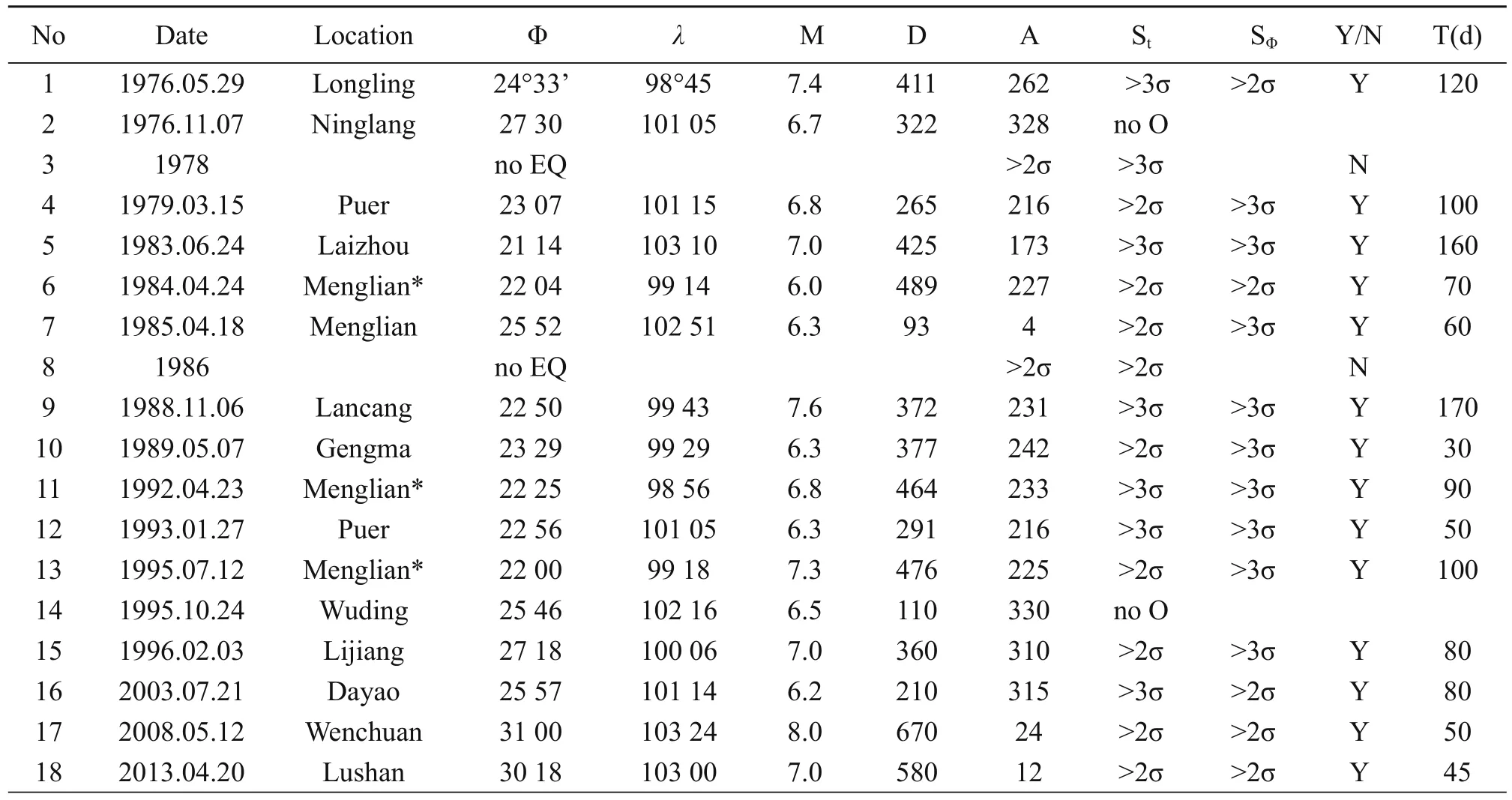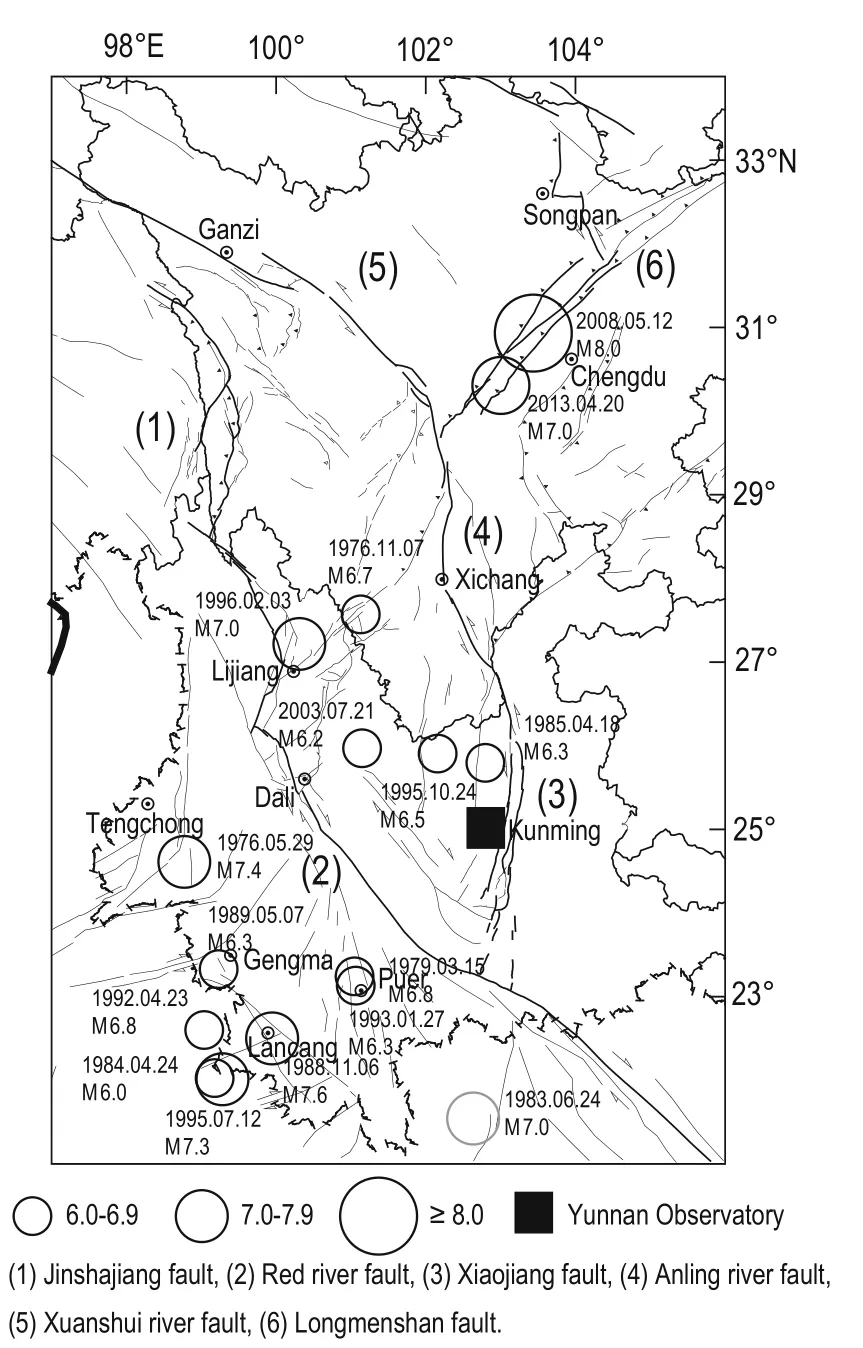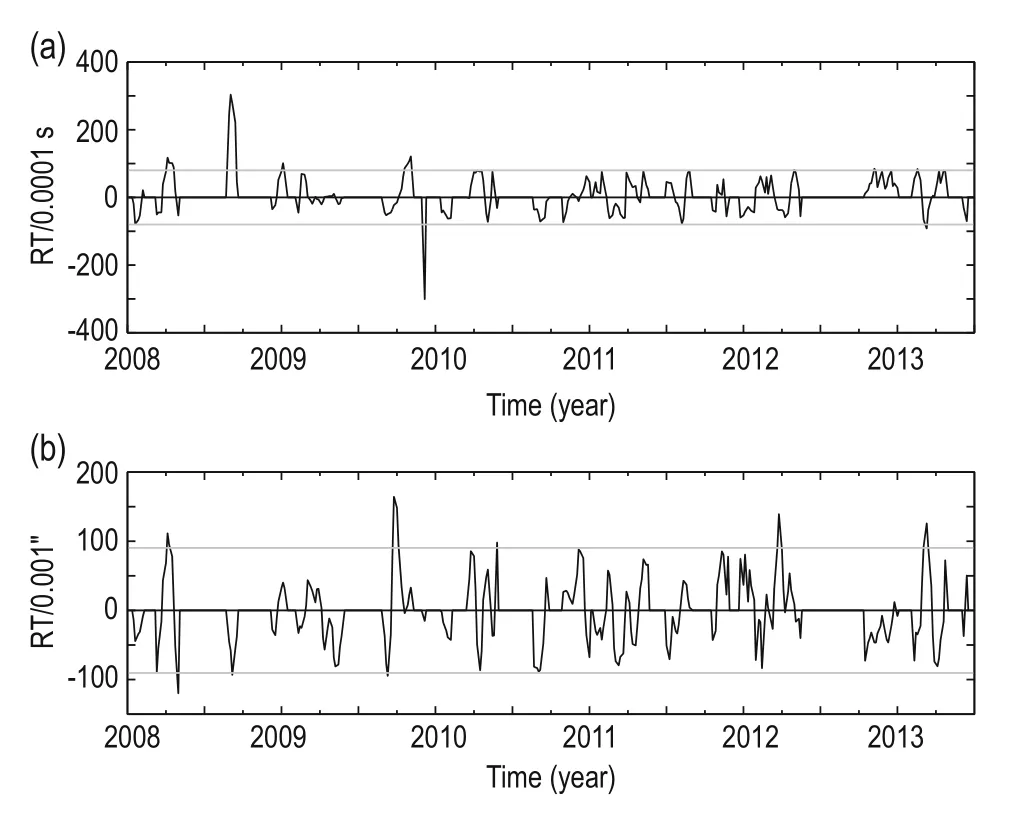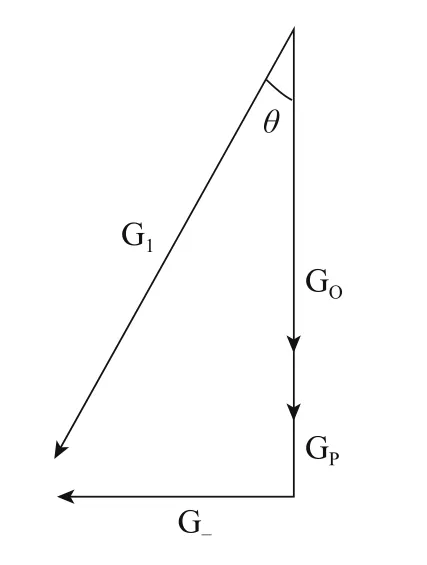Anomalous astronomical time-latitude residuals: a potential earthquake precursor*
Hu Hui, Su You-Jin, Gao Yi-Fei, and Wang Rui
Anomalous astronomical time-latitude residuals: a potential earthquake precursor*
Hu Hui1, Su You-Jin2, Gao Yi-Fei1, and Wang Rui1
The geophysical mechanism behind astronomical time–latitude residuals (ATLR) are discussed. The photoelectric astrolabe at Yunnan Observatory (YO) observed apparent synchronous anomalous ATLR before the Wenchuan M8.0 earthquake (EQ) in May 12, 2008 and the Lushan M7.0 EQ n April 20, 2013. We compared the ATLR from the YO photoelectric astrolabe and EQ data since 1976. Anomalous ATLR was observed before several strong EQs in the Yunnan Province. We believe the photoelectric astrolabe can be used to predict strong EQs and the anomalous ATLR are a potential EQ precursor.
Time-latitude residuals, plumb line, groundwater, earthquake
Introduction
Strong earthquakes (EQ) are common and occur without warning incurring loss of lives and property, e.g., the 2004 M9.0 EQ in Sumatra, the 2010 M8.0 EQ in Chile, the 2011 M9.0 EQ in Honshu, and the 2015 M8.2 EQ in Nepal, etc. Within 11 years, eight EQs of M≥ 8.0 have occurred. The disasters associated with highmagnitude EQs remind us that we must continue our efforts to strengthen our research on cause of formation, mechanism, prediction and forecast of EQs. The latter is considered an extremely difficult to solve problem, in particular, because there are no clearly identifiable EQ precursors (Geller et al., 1997). In fact, many researchers still continue to conduct research, trying to find an effective method for EQ prediction, for example, Weng’s commensurability (Weng, 1981; Hu and Han, 2005; Hu et al., 2013), Yang’s, earth rotation, polar migration and crustal deformation (Yang and Wang, 1995), Men’s Ordered network (Men, 1994; Men and Li, 2000), Gou’s the double method of magnetic storm and three of the dynamic and static method (Guo et al., 2003a, 2003b), and Li’s the earthquake warning system upon the planet earth (Li, 2006, 2010).
Several studies have shown that accurate optical astrometric measurements may. After the 1976 M7.8 EQ in the Tangshan region of China, the Beijing Astronomical Observatory of the Chinese Academy of Sciences found that short-term anomalous variations appeared in the astronomical time–latitude residuals (ATLR) of observations obtained by an astrolabe in the Shahe observational station just before the EQ. ATLR are obtained after removing the effects of the Earth’s rotation from the astronomical time and latitude observations. The phenomenon was tested by analyzing the observations from many astrometric instruments globally (Li et al., 1978). These studies showed that the anomalous variation of the local plumb line owing to the motion of groundmass before EQs possibly is the mainreason of the ATLR anomalies. The local plumb line is the benchmark of the optical astrometric measurements (Zhang, 1981). Thus, the ATLR are potentially a rich source of information.
The results were submitted to the 19th General Assembly of the International Astronomical Union (IAU) in 1985. The 19th Committee (Earth rotation committee) pointed out that optical astrometric observations of latitude and universal time might be valuable for studying geophysical phenomena (Swing, 1985). The significance of optical astrometric observations in studying the variation of the plumb line was emphasized by the 19th commission of IAU again in 1988 and 1991 (Kotaczel, 1988; Bergeron, 1991). During these years, researchers from the Beijing Astronomical Observatory and YO carried out in-depth studies of the possibility of predicting strong EQ by using the ATLR (Li et al., 1991; Han, 1993; Han and Tian 1993; Hu et al., 1989). Researchers at the Shanghai Observatory carried out similar work (Zheng and Zhou, 1995; Liao et al., 1994). They discovered significantly abnormalities in the time residuals measured by transit instruments and in the time–latitude residuals measured by astrolabe before the June 5, 1990 Taichung M5.0 EQ in Jiangsu province (Liao and Zheng, 1990). The results unanimously show that the anomaly of ATLR before strong EQs may be an effective EQ precursor. As the YO is located in Yunnan, which is a seismically active area, the Yunnan Observatory has been cooperating with the Seismological Bureau of the Yunnan Province in the possible application of ATLR in EQ prediction. After an EQ of magnitude 6.1 in the Luquan County of the Yunnan Province, on April 18, 1985, Han et al. (1987) analyzed the astronomical time and latitude obtained with the photoelectric astrolabe in the Yunnan Observatory and found that the half-month mean ATLR shows greater anomalies within nearly a month before the EQ. We have analyzed all ATLR measured by the photoelectric astrolabe at YO (Hu et al., 1994; Hu et al., 1996; Hu and Han, 1997; Hu et al., 2007) and constructed an EQ prediction model. We used the model to produce alerts before six EQs. The ATLR of the photoelectric astrolabe at YO showed apparent synchronous anomalies before the Wenchuan M8.0 EQ in May 12, 2008 and the Lushan M7.0 EQ in April 20, 2013.
Definition of the astronomical time–latitude residuals and anomalies
The astronomical time–latitude residuals for a certain astrometric instrument are obtained after removing the effects of the Earth’s rotation (rotational rate and polar motion) from the astronomical time and latitude. The Earth’s rotational motion, i.e., Earth’s rotational rate and polar motion are usually expressed by the universal time (UT1–UTC) and the coordinate of the northern pole of the Earth’s rotational axis on the Earth’s surface (x, y). The Universal time (UT1–UTC) and polar motion are from the integrated results of many global astronomical time and latitude observations. Before the 1980s, global observations were taken by transit instrument, astrolabe, photoelectric astrolabe, zenith telescope, zenith tube, and optical astrometric instruments. Presently, these data are obtained by long baseline interferometry (VLBI), lunar laser ranging (LLR), satellite laser ranging (SLR), and global positioning system (GPS). The time residual RTjand latitude residual RLjdetermined by an instrument j are (Hu et al., 1989)

where (UT0–UTC) is the original universal time obtained and calculated with the instrument, Δλ is the corrected value, which is related to the polar motion, from the UT0–UTC system to the UT1–UTC system. The UT1–UTC is the artificial the universal time of the specific date, and dΦjand dΦcare respectively the variations of the latitude determined by the instrument and the polar latitude variation of the homologous time. Δλjand dΦcare (Hu et al., 1989)

where X and Y are the artificial coordinates of the Earth’s pole of the homologous time, λjand Φjare respectively the longitude and latitude of the instrument. (UT1–UTC), and X and Y are provided by the International Earth Rotation Service (IERS). Thus, the ATLR of the instrument is estimated by using the above equations.
The anomalous ATLR refer to anomalies with absolute deviations between the time residuals and latitude residuals greater than or equal to two times their standard deviation (2σ). We take the synchronized anomalies of the time and latitude residuals as a warning before the occurrence of strong EQs.
ATLR of photoelectric astrolabe at YO and strong EQs around YO
The astronomical time and-latitude observations with the photoelectric astrolabe in YO began in December of 1975. According to the abovementioned definitions and data processing (Kimura, 1902; BIH, 1984; Bendat and Piersol, 1971), we analyzed in detail all the instrument data. The relation between the anomalous ATLR and the strong EQs around YO are given in Table 1. It is seen that there is good correspondence between the anomalies and strong EQs. Anomalies greater than 2σ appeared before all major EQs of magnitude 6.0. Two of the EQs occurred in Ninglang in November 7, 1976 and Wuding in October 24, 1995. However, there were no observations before the two EQs.
The anomalous ATLR resemble other geophysical phenomena related to EQs. They typically appear two to three months before an EQ. Statistical analysis showed that for an EQ of magnitude greater than about 6, the distance of the warning signs of ATLR may reach about 300–400 km and there is no reaction when the distance between the instrument and the epicenter is greater than that.
Since the start of the observations, only two major nonseismic anomalies were observed. The first, in 1978, had an RT anomaly >2σ and an RL anomaly >3σ. The second, in 1986, had an RT anomaly >2σ and an RL anomaly >2σ. We noticed that the two anomalies were not synchronous and considered this a nonseismic sign. Subsequently, we used the distribution of anomalies greater than 2σ in the entire the residual curve to evaluate the synchronicity of the two anomalies. They were called synchronous or asynchronous and we checked the fluctuation of the residuals. When the time distribution of the anomalies is >2σ, the time of the first decreases or matches the second, and the condition can be regarded as synchronous.
Basic synchronization occurs when there are overlapping parts with peak differences of five days or so. The anomalies in the time latitude residuals are not synchronized, which means that the anomalous peaks are time inconsistencies. From Table 1, we see that the time lags between the anomalous signals and the major EQs is generally about two to three months but sometimes it is longer, e.g., 100 days or more. Especially, the time lag between the anomaly signals and the 1988 EQ in Lancang (M7.6) was about 170 days. However, we also noticed that some geophysical anomalies appear earlier, e.g., several months or half a year. For example, some geophysical anomalies appeared in the end of 1994before the Menglian M7.3 EQ that occurred in July 12, 1995 (Chen and Fu, 2004). Perhaps the time lag was large for the Menglian M7.3 EQ. In addition, we did not find a relation between the anomalies and the epicenter and magnitude although sometimes EQs of moderate magnitudes and large epicentral distances were not reflected in the ATLR. We considered the possibility of estimating the orientation of the epicenter by using three or four instruments, for distances between the instruments of about 200–300 km, and setting up an observational net in seismically active regions (Han et al., 1994).

Table 1 Anomalies of the time–latitude residuals and strong earthquakes around YO
We obtained the anomalous ATLRs from the Seismological Bureau of the Yunnan Province before six EQs. The data are given in Table 1 and are No. 11, No. 12, No. 13, No. 15, No. 16, and No. 18, respectively. Kan and Hu (1995) suggested that the anomalous ATLR are precursors and verified the correspondence between the anomalies and strong EQs. Because only one observatory is presently studying these anomalies and there is no observation network, the date, place, and magnitude of EQs cannot be established (Kan and Hu, 1995).
In Figure 1, we mark the date and magnitude of the EQs but not the locality because many EQs haveoccurred in the same location.

Fig.1 Geological structure of the Xikang-Yunnan fault block.
The ATLR anomalies at YO before the Wenchuan and Lushan EQ
An M8.0 EQ occurred in the Wenchuan County of the Sichuan Province of China in May 12, 2008. After five years, another M7.0 EQ occurred in the Lushan County of the Sichuan Province in April 20, 2013. The two massive EQs caused many deaths and property damages, especially the Wenchuan EQ.
In March of 2008 and March of 2013, two synchronous anomalies greater than 2σ appeared in the RT and RL of the photoelectric astrolabe at YO (Figure 2). Since the 2003 Dayao EQ to that of February of 2008 and from then on to February of 2013, no synchronous anomalies greater than 2σ in the ATLR of the photoelectric astrolabe at YO were observed. Likewise, during these two periods, no EQ M ≥ 6.0 occurred around YO. The epicenters of the M8.0 Wenchuan EQ and the M7.0 Lushan EQ away from YO were about respectively at 670 km and 580 km. Despite the great distance from Wenchuan and Lushan to YO, both epicenters were located on the Xikang–Yunnan fault block. Long et al. (2006) used historical EQs in this block to predict that an EQ 8.0 will occur in the Wenchuan region in 2008. Therefore, the two synchronous anomalies in March of 2008 and 2013 may have been warnings of the M8.0 Wenchuan EQ 8.0 and M7.0 Lushan EQ. In Figure 2, the September of 2008 synchronous anomalies may be related with the M4.3 EQ that occurred at Kunming with an epicenter only 24 km away from YO.

Fig.2 Residuals of the astronomical time (a) and latitude (b) of YO from 2008.0 to 2013.5.
Mechanism
The optical astrometric instruments use the local plumb line as reference. The reason of the ATLR anomalies is attributed to change of the plumb line owing to the motion of the groundmass before EQs. Zhang (1981) found that the migration of ground water is main form of motion of the groundmass before strong EQs. Groundwater migrated in the vertically and horizontally. He also found that the groundwater movement variations are greater in the horizontal direction than the vertical, and this is presumably the reason for the large ATLR anomalies (Bendat and Piersol, 1971).
Figure 3 shows the gravitational acceleration G0of a region. Because of the underground mass in the region, the gravitational acceleration becomes G1. The change can be separated into Gpand G_. It is evident that Gpcan be measured by a gravimeter, whereas the horizontal component G_cannot. Angle θ can be measured by optical astrometric instruments and G_can be obtained from angle θ with the following equation


Fig.3 Schematic of the gravitational acceleration variation.
The units of angle θ in the above equation are arcsecond. The parameter monitored by the ATLR is the change in the horizontal component of gravity. It is monitored on the surface and not on a point. Thus, the monitoring of the ATLR shows the changes of the gravitational field over a wide range.
In addition, Kan et al. (1977) considered that the deviation of the plumb line might be caused by block movements in the plate before an EQ. We think that both these factors are possible and require further study. Either the motion of groundwater or block movements in the plate may cause the variations in the geophysical field around the EQ area. The magnitude and direction of the gravity at any point on the Earth’s surface are determined by the distribution of groundmass. On other hand, in general, EQs are created by breaking of the crust owing to stress. During accumulation of stress, the density in some areas increases and in others decreases, causing regional gravity variations (Barnes, 1966; Li et al., 1989; Barlik anf Rogowski, 1989; Li and Li, 2008, 2009; Chen et al., 1979; Hu et al., 2003).
Conclusions
ATLR anomalies before strong EQs were identified by scientists at the Beijng Astronomical Observatory after the 1976 Tangshan EQ. They collected ATLR data from more than ten observatories worldwide and EQ data in nearby regions, and analyzed several hundred thousand data. The results suggested that ATLR anomalies were observed and recorded by all the observatories several weeks or months before most EQs above M6.0. Since the 1985 Luquan earthquake, we have carried out related research using the ATLR of the photoelectric astrolabe at the YO (Yunnan Observatory) and strong earthquakes around the YO. In cooperation with the Yunnan Seismological Bureau, we analyzed the photoelectric astrolabe data and found significant synchronous anomalies in the ATLR before M≥6.0 EQs within 700 km of the YO, except the lack of data because of the rainy season before the Wuding earthquake in October 20, 1995. Then, we analyzed real-time observations of the photoelectric astrolabe at the YO, which agrees with the above. Clearly, the ATLR anomalies may be a potential precursor and deserves further attention.
Acknowledgements
Dr. Chen I-wan, advisor to the Natural Hazards Prediction Committee of the China Geophysics Society provided valuable comments.
Barlik, M., and Rogowski, J. B., 1989, Variations of the plumb-line direction obtained from astronomical and gravimetric observations: Prace Nauk Politech Warsz,33, 19–101.
Barnes, D. F., 1966, Gravity changes during the Alaska earthquake: J. Geophys. Res., 71, 451-456.
Bendat, J. S. and Piersol, A. G., 1971, Random data: Analysis and measurement procedures: Wiley-Interscience (A division of John Wiley & Sons, Inc.), New York-London-Sydney.
Bergeron, J., 1991, Transactions of the International Astronomical Union, Vol. XXIB: Proceeding of the Twenty-First General Assembly, Buenos Aires, Kluwer Academic Publishers, pp. 209.
BIH (Bureau International de l’Heure), 1984, Annual Report for 1983, Paris.
Chen, L. D., and Fu, H., 2004, Base and Experience of Earthquake Prediction (in Chinese): Seismic Press, Beijing, 33-45.
Chen, Y. T., Gu, H. D. and Lu, Z. X., 1979, Variations of gravity before and after the Haicheng earthquake, 1975, and the Tangshan earthquake, 1976: Phys. Earth Planet Interiors, 18, 330–338.
Geller, R. J., Jackson, D. D., Kagan, Y. Y. and Mulargia, F., 1997, Earthquakes cannot be predicted: Science, 275, 1616–1617.
Guo, Z. J., Han, Y. B., and Wu, J. B., 2003a, By three of the dynamic and static method to predict earthquakes criterion: Earth science frontiers (in Chinese), 10(1), 70-70.
Guo, Z. J., Han, Y. B., and Wu, J. B., 2003b, Discussion on the physical mechanism of predicting big earthquakes by means of the double method of magnetic storm: South China Journal of Seismology (in Chinese), 23(1), 38-41. Han, Y. B., 1993, Relationship between residual anomalies of time-latitude and earthquakes: Chinese Science Bulletin, 38, 303–307.
Han, Y. B., Hu, H., and Du, H. R., 1987, Occurrence of short-period anomaly of residuals of astronomical timelatitude at Yunnan observatory preceding the Luquan earthquake (ML = 6.3): Chinese Science Bulletin, 32(17), 1205–1207.
Han, Y. B. and Tian, J., 1993, Method and application software providing information on earthquake prediction with the classical astrometric observations: publ. of Beijing Astron. Obs., 22, 41-44.
Han, Y. B., Zhang, G. D., Hu, H., and Zhao, F. S., 1994, Significance and feasibility of constructing Yunnan astronomical time-latitude seismic net: Journal of Seismological Research (in Chinese), 17(1), 1-6.
Hu, H., and Han, Y. B., 1997, Aplication of the anomaly of astrometric observations to earthquake prediction study: In Forsberg, R., Feissel, M., Dietrich, R., (eds), International association of geodesy symposia, IAG scientific assembly, Rio de Janeiro, Springer Press, 119, 460-464.
Hu, H., and Han, Y. B., 2005, Prediction of the Hualian earthquakes in Taiwan and an extended discusion on the method of commensurability: Applied Geophysics, 2(3), 194-196
Hu, H., Han, Y., Su, Y. J., et al., 2013, Commensurability of earthquake occurrence: Journal of Asian Earth Sciences, 70-71, 27-34.
Hu, H., Kan, R. J., and Li, X. M., 1996, Application of the residuals of astronomic time and latitude in the earthquake prediction: Chinese Science Bulletin, 41(13), 1104-1106.
Hu, H., Kan, R. J., Wang, R., Cai, X., and Chen, C. X., 1989, A method for predicting a strong earthquake by means of astrometric observations: Astron Astrophys, 224, 321–322.
Hu, H., Li, Z. X., Li, H., and Fu, G. Y, 2003, Internnual variations of the vertical at Yunna by astrometry and gravimetry techniques: Journal of Natural Disasters (in Chinese), 12(2), 25-27.
Hu, H., Su, Y. J., Fu, H., Han, Y. B., Wang, R., and Ma, L. H., 2007, Anomalies in time-latitude residuals at Yunnan Observatory before Dayao and Puer earthquakes: Journal of Natural Disasters (in Chinese), 16(5), 106–110.
Hu, H., Wang, R., Kan, R. J., and Zhao, H. S., 1994, Occurrence of the short-term anomaly of residuals of astronomic time-latitude at Yunnan Observatory before the Puer earthquake: In Proceedings, International Workshop on Seismotectonics and Seismic Hazard in South East Asia, Hanoi-Vietnam, 52-56.
Kan, R. J., and Hu, H., 1995, The major earthquakes in and around Yunnan and variation of astronomical timelatitude residuals determined in Yunnan Observatory: Earthquake Res. China, 11(4), 299–309.
Kan, R. J., Zhang, S. C., Yan, F. T. and Yu, L. S., 1977, Discussion on the characteristics of the modem tectonic stress field and modern tectonic activities in Southwest China: Acta Geophysica Sinica (in Chinese), 20(2), 96-109.
Kimura, H., 1902, A new annual term in the variation of latitude independent of the components of the pole' motion: Astronomical Journal, 22, 107-108.
Kotaczel, B., 1988, Transactions of the International Astronomical Union, Vol. XXB: Proceeding of the Nineteenth General Assembly, Baltimore, Kluwer Academic Publishers, pp.197.
Liao, D. C., Jin, W. J., Zheng, D. W., and Wang, S. H., 1994, An analysis of optical observations in China during 1986 to 1991: Ann Shanghai Observatory Acad Sin. (in Chinese), 15, 28–33.
Liao, D. C., and Zheng, D. W., 1990, Earthquake (MS=5) in Taicang and anomalous residuals of time determinationat Shanghai Observatory: Chinese Science Bulletin, 35(23), 1838–1839.
Li, Y., 2006, An examination of the correlation between earthquake, positions of solar system bodies and solid tide: Science in China Series G, 49(3), 367-376.
Li, Y., 2010, Modeling earthquake indexes derived from the earthquake warning system upon the planet earth: Science in China Series G, 53(12), 2293-2299.
Li, Z. S., Han, Y. B., and Tian, J., 1989, A possible geoghysical explanation for abnormal residual fluctuations of astronaomical time and latitue: Ann Shanghai Observatory Acad Sin. (in Chinese), 10, 16–22. Li, Z. S., Han, Y. B., and Tian, J., 1991, A possible warning sign of major earthquake through observations of astronomical time and latitude: Astrophysics and Space Science, 17, 383-384.
Li, Z. S., Zhang, G. D., Zhang, H. Z., and Liu, X. J., 1978, Relationship between the short-term anomaly of astronomical time-latitude observation and the strong earthquakes around the observatory: Acta Geophysical Sinica (in Chinese), 4, 278-291.
Li, Z. X., and Li, H., 2008, Correlation between plumb line variations and earthquakes around at Tangshan during 1987 to 1998: Sci. China Ser. D-Earth Sci., 38, 432–438.
Li, Z. X., and Li, H., 2009, Earthquake-related gravity field changes at Beijing-Tangshan gravimetric network during 1987–1998: Stud. Geophys. Geodaet., 53, 185–197.
Long, X. X., Yan, J. P., Sun, H., and Wang, Z. Z., 2006, Study on earthquake tendency in Sichuan-Yunnan Region based on commensurability: Journal of Catastrophology (in Chinese), 21(3), 81–84.
Men, K. P., 1994, Study on prediction of strong earthquakes (M ≥ 7) in Xinjiang and nearby area: Northwestern Seismological Journal (in Chinese), 16(4), 29-36.
Men, K. P., and Li, D., 2000, Prediction for trend of strong earthquakes in the Southern Yellow Sea area: Northwestern Seismological Journal (in Chinese), 22(2), 134-138.
Swing, J. P., 1985, Transactions of the International Astronomical Union, Vol. XIXB: Proceeding of the Nineteenth General Assembly, Delhi, Kluwer Academic Publishers, pp.175.
Weng, W. B., 1981, “Commensurability: - Acta Geophysical Sinica, 24(4), 151-154 ,
Yang, X. X., and Wang, L., 1995, Earth rotation, polar migration and crustal deformation: Crustal Deformation and Earthquake (in Chinese), 15(2), 74-82.
Zhang, G. D., 1981, The variation in the vertical line caused by the activity of the underground water before a strong earthquake: Acta Seismological Sinica (in Chinese), 3(2), 152-158.
Zheng, D. W., and Zhou, Y. H., 1995, Studies of the relations between the earth rotation and global earthquake activities: Acta Seismol Sin. (in Chinese), 17, 25–30.

Hu Hui, Professor, graduated from the astronomical department of Beijing Normal University in 1968. He is interested in astrometry, earthquakes, and natural hazards for a long time. He has published near 100 scientific papers at home and abroad.
Manuscript received by the Editor December 15, 2015; revised manuscript received June 15, 2016.
*This work was supported by the Ministry of Science and Technology of P.R. China (No. 2012BAK19B01-07).
1. Yunnan Observatory, Chinese Academy of Sciences, Kunming 650011, China.
2. Seismological Bureau of Yunnan Province, Kunming 650224, China.
© 2016 The Editorial Department of APPLIED GEOPHYSICS. All rights reserved.
- Applied Geophysics的其它文章
- Broadband seismic illumination and resolution analyses based on staining algorithm*
- Spherical cap harmonic analysis of regional magnetic anomalies based on CHAMP satellite data*
- 3D finite-difference modeling algorithm and anomaly features of ZTEM*
- Three-dimensional numerical modeling of fullspace transient electromagnetic responses of water in goaf*
- Coherence estimation algorithm using Kendall’s concordance measurement on seismic data*
- 3D modeling of geological anomalies based on segmentation of multiattribute fusion*

